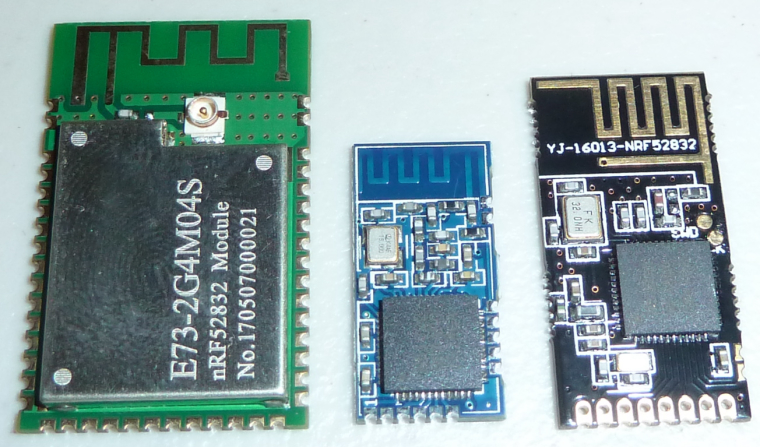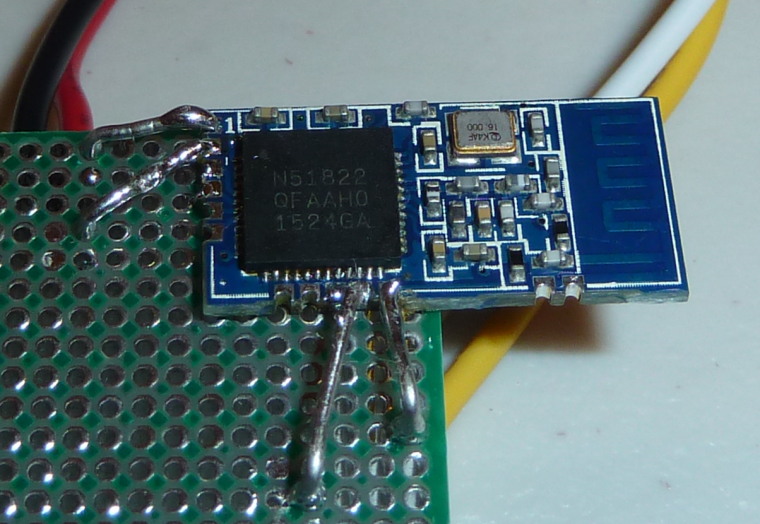nRF5 action!
-
@NeverDie said in nRF5 Bluetooth action!:
@NeverDie said in nRF5 Bluetooth action!:
MY_PASSIVE_NODE,
I found a shlocky workaround for the current problems with MY_PASSIVE_NODE. It turns out that if you have the gateway up and running before the passive node power up, then the passive node often gets stuck in a loop trying to register itself. However, for whatever reason, if you first power up the passive node, let it run for a bit trying to register and failing, and then power on the gateway, the loop is avoided. Then the passive node will broadcast one packet per cycle and the gateway will receive it and send it to the serial port.
Unfortunately, Domoticz can't really deal with it.
Soooooo... For now, I'm using Termite on the serial port to capture the packets and time stamp them. That at least allows me to continue with measurements as to whether MY_PASSIVE_NODE saves significant energy or not. It also has 1 second resolution, not the 5 minute time resoluton of Domoticz.
Good news! Using the above method, I've established that the EByte nRF52832 module consumes an order of magnitude less current if "MY_PASSIVE_NODE" is defined. :) :) :)
@NeverDie said in nRF5 Bluetooth action!:
Good news! Using the above method, I've established that the EByte nRF52832 module consumes an order of magnitude less current if "MY_PASSIVE_NODE" is defined. :) :) :)
Does that mean you are reaching consumption levels as low as atmega+nrf24 ?
-
@NeverDie said in nRF5 Bluetooth action!:
Good news! Using the above method, I've established that the EByte nRF52832 module consumes an order of magnitude less current if "MY_PASSIVE_NODE" is defined. :) :) :)
Does that mean you are reaching consumption levels as low as atmega+nrf24 ?
@Nca78 said in nRF5 Bluetooth action!:
@NeverDie said in nRF5 Bluetooth action!:
Good news! Using the above method, I've established that the EByte nRF52832 module consumes an order of magnitude less current if "MY_PASSIVE_NODE" is defined. :) :) :)
Does that mean you are reaching consumption levels as low as atmega+nrf24 ?
Not for all cases, but maybe for this case, provided I can run it off of both of its internal resonators (the 32Khz and the 64Mhz). The datasheet promises a "fast wakeup" if run off the internal 64mHz resonator, and its access to the radio should be a lot faster through DMA, which is automatic.
Presently, running it all night long (12 hours), it lost less than 50mv off the supercap, and some of that is probably just self-discharge by the supercap.
Also, getting the DCDC to work would no doubt help...
-
Maybe using the internal oscillator doesn't matter. Thge datasheet says, "The HFXO must be running to use the RADIO..."
i.e. without the external 64Mhz oscillator, the radio can't be used. So, if that's true, then I guess from my point of view the 64Mhz external oscillator isn't optional after all. Perhaps that explains why there is one on literaly every module I've seen so far.
-
I'm ordering today some AVX supercaps with smaller Farad values so that I can get more resolution on the amount of energy (at least relatively) being consumed in different configurations.
-
I received the nRF51822 modules I had ordered (center of photograph):

Small enough to fit almost anywhere! -
@rmtucker said in nRF5 Bluetooth action!:
I tried my nrf24l01 pa lna sma but it seemed to be only working every now and again so waiting on a new one being delivered.
According to hackaday, there's a certain very common model which doesn't perform well unless you wrap it first in saran wrap (as an electrical insulator) and then in aluminum foil (except for the antenna, obviously).
-
@NeverDie
I connected a new amplified nrf24 to the gateway with the tin foil as mentioned and it is reading -60dB compared to -89dB with the non amplified version.
Now lets see how far it goes past the original test.😉 -
@NeverDie
I connected a new amplified nrf24 to the gateway with the tin foil as mentioned and it is reading -60dB compared to -89dB with the non amplified version.
Now lets see how far it goes past the original test.😉@rmtucker said in nRF5 Bluetooth action!:
@NeverDie
I connected a new amplified nrf24 to the gateway with the tin foil as mentioned and it is reading -60dB compared to -89dB with the non amplified version.Did the tin foil make a difference? Hackaday seemed to think it made a big difference. I haven't tried it yet.
-
@rmtucker said in nRF5 Bluetooth action!:
@NeverDie
I connected a new amplified nrf24 to the gateway with the tin foil as mentioned and it is reading -60dB compared to -89dB with the non amplified version.Did the tin foil make a difference? Hackaday seemed to think it made a big difference. I haven't tried it yet.
@NeverDie said in nRF5 Bluetooth action!:
@rmtucker said in nRF5 Bluetooth action!:
@NeverDie
I connected a new amplified nrf24 to the gateway with the tin foil as mentioned and it is reading -60dB compared to -89dB with the non amplified version.Did the tin foil make a difference? Hackaday seemed to think it made a big difference. I haven't tried it yet.
I think it did but what do you have to lose😉
-
Here's the Hackaday article: http://hackaday.com/2016/05/31/fixing-the-terrible-range-of-your-cheap-nrf24l01-palna-module/
-
@NeverDie said in nRF5 Bluetooth action!:
@Nca78
Did you ever figure out how to reset the MCU on the Ebyte module?Sorry didn't touch my NRF5 in the last weeks. A bit busy on other things...
-
What's the best way to make a "receive only" gateway? i.e. one that cannot transmit? Then I wouldn't need to worry about whether the gateway is turned on before powering up a MY_PASSIVE_NODE sensor mote. Is there a way to do it simply in hardware, or do I have to sabotage the gateway library code?
-
It's getting too baroque. What I'd really like to have is a short nRF5 library of just the bare essentials (like the MIRF library is for the RF24).
-
Hmmm... it looks like radiohead may be such a library: http://www.airspayce.com/mikem/arduino/RadioHead/classRH__NRF52.html
-
It's getting too baroque. What I'd really like to have is a short nRF5 library of just the bare essentials (like the MIRF library is for the RF24).
@NeverDie said in nRF5 Bluetooth action!:
It's getting too baroque. What I'd really like to have is a short nRF5 library of just the bare essentials (like the MIRF library is for the RF24).
You can take a look into the actual Nordic NRF SDK. There are the ESB library for nRF24 compatible communication.
-
@NeverDie said in nRF5 Bluetooth action!:
It's getting too baroque. What I'd really like to have is a short nRF5 library of just the bare essentials (like the MIRF library is for the RF24).
You can take a look into the actual Nordic NRF SDK. There are the ESB library for nRF24 compatible communication.
@d00616 said in nRF5 Bluetooth action!:
@NeverDie said in nRF5 Bluetooth action!:
It's getting too baroque. What I'd really like to have is a short nRF5 library of just the bare essentials (like the MIRF library is for the RF24).
You can take a look into the actual Nordic NRF SDK. There are the ESB library for nRF24 compatible communication.
The RadioHead library seems very easy to pickup and start using. Maybe it's me, but I can't say the same for the Nordic SDK.
Interestingly, it looks as though @Yveaux may (?) have written the nRF51 part of the RadioHead library.
-
I was able to program the tiny nRF51822 (earlier photograph above) by programming it as an xxaa Generic nRF51 with an RC oscillator.
Nice!
-
Here's a close-up photo:

-
FWIW, range on the tiny nRF51822 does seem compromised when compared against larger sized nRF52832 modules. Not really surprising, but I had hoped it might be a little better than it is.
